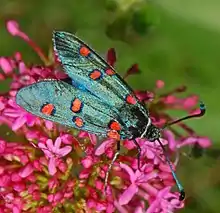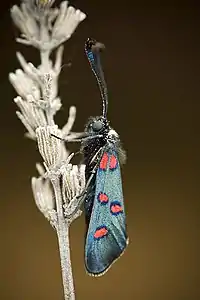Zygaena lavandulae
Zygaena lavandulae is a species of moth in the family Zygaenidae.
| Zygaena lavandulae | |
|---|---|
 | |
| Zygaena lavandulae, upperside | |
| Scientific classification | |
| Kingdom: | |
| Phylum: | |
| Class: | |
| Order: | |
| Family: | |
| Genus: | |
| Species: | Z. lavandulae |
| Binomial name | |
| Zygaena lavandulae (Esper, 1783) | |
| Synonyms | |
| |
Subspecies
Subspecies include:[1][2]
- Zygaena lavandulae lavandulae
- Zygaena lavandulae alfacarica Tremewan, 1961
- Zygaena lavandulae barcelonica Reiss, 1936
- Zygaena lavandulae consobrina Germar, 1836
- Zygaena lavandulae espunnensis Reiss, 1922
- Zygaena lavandulae micheaellae Rungs & Le Charles, 1943
Distribution

This species can be found in Southern France, eastern Spain, Portugal and Italy (only in central and western Liguria),[3] as well as North Africa, including Morocco.[4][5]
Description
Zygaena lavandulae has a wingspan of 31–36 millimetres (1.2–1.4 in) in males and of 35–37 millimetres (1.4–1.5 in) in females. The head is black. The thorax is black with a white collar. Also the abdomen is black, with a slight blue gloss. Forewings are bluish, with five red spots surrounded with black or dark blue. Hindwings are bluish-black with a very large distal red spot. Colorations of the females are rather similar to males, but their forewings are usually bluish-green, with larger spots.[6]
Habitat
These moths mainly inhabit rocky places, dry woods and grove rich grasslands.[5] They are present in the Maquis shrubland, characterized by the widespread presence of Cistus species.
Biology
There is one generation per year (univoltine). The larvae feed on Dorycnium pentaphyllum[5] and Anthyllis cytisoides.[7] They develop until April without real dormancy.[5] Adults are on wing from April to June.[5]
References
- Lepiforum.de
- Biolib
- Fauna Europaea
- Zygaena at funet
- Lepidoptera and their ecology at Schmetterlinge und ihre Ökologie
- Tutt, James William Notes on Zygaena species The entomologist's record and journal of variation – Vol. 72 (1960), pg 5
- Paolo Mazzei, Daniel Morel, Raniero Panfili Moths and Butterflies of Europe and North Africa